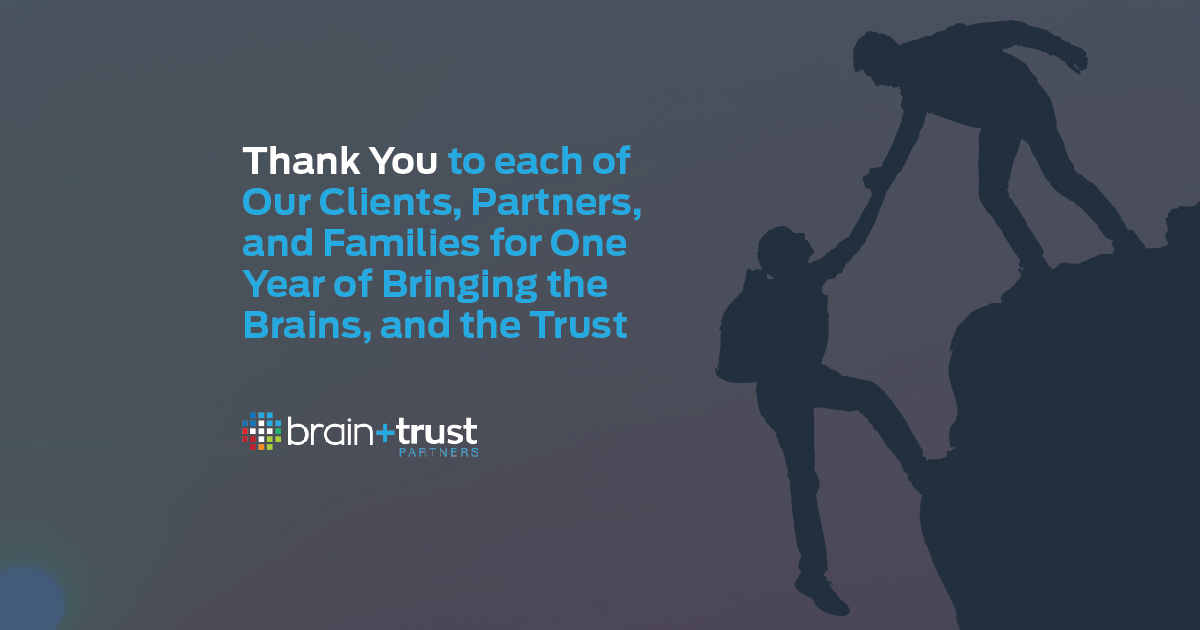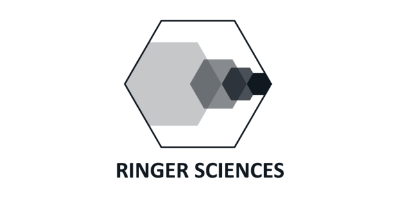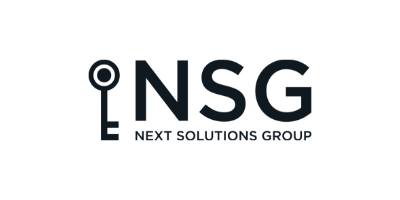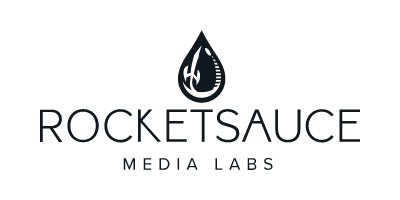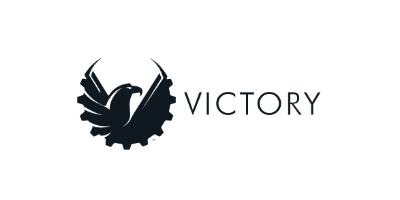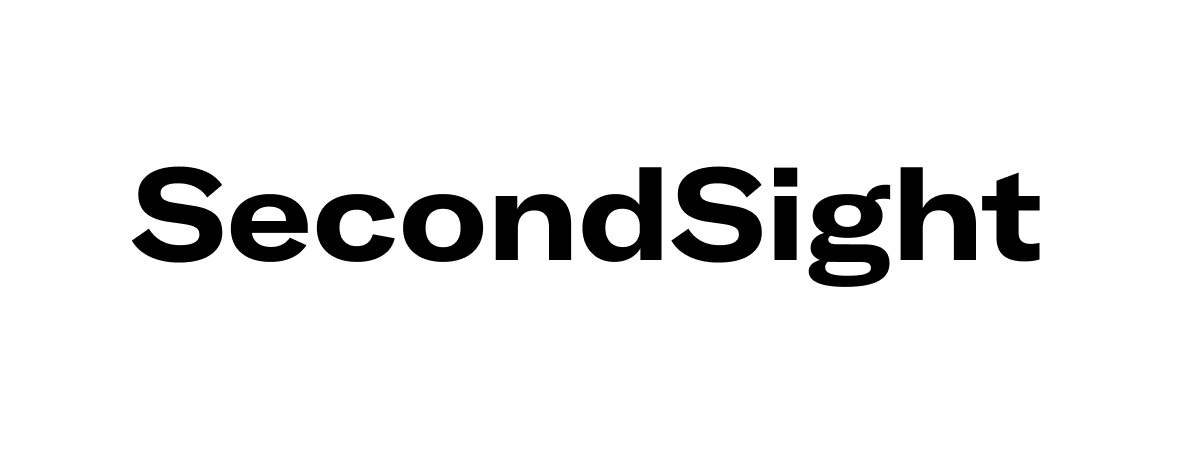I’ve been in the “real world” in business for about two decades, and I’ve been “doing digital” for almost 14 years — about two-thirds of my career. For 19 of those years, I was a corporate animal, working either directly for or as agency support of some of the world’s biggest companies. Then, one year ago last month, my business partners and I started Brain+Trust Partners — and I joined the ranks of the small business owners and entrepreneurs.
Any anniversary brings with it the opportunity to look both back and forward, and Brain+Trust Partners’ birthday is no exception. Certainly, much is different from the beginning of my career and even the beginning of our company — and we foresee even more dramatic changes are coming in the next year.
What Is Past Is Prologue
I got started in digital in 2003, back when “social media” was largely defined as blogging and podcasting — before Facebook opened to anyone out of college OR brands, before Twitter was a gleam in anyone’s eye (or before we experienced that it might help win a presidential election!), before analytics tools or listening or monitoring.
Back in the early days of social media, the big promise we were all so excited about was the idea that thanks to social, customer relationships could be flipped on their head; instead of customers being on the one-way end of mass communication, they could have direct conversations and even relationships with brands. The benefit to customers would be obvious: they would have the ability to provide direct feedback to companies and organizations about their efforts, and more control of the brand-customer interaction. For their part, brands would be able to hear directly from their audiences and might have better insights into audience desires than ever before.
Somewhere along the way, we lost that promise. There were some visionary marketers who understood the potential and benefit of those customer-centric communications and relationships, but for the most part we turned social media over to marketing and ad departments (or newly created “digital” departments made up of traditional marketers), who in turn used social and digital channels to do the exact kind of broadcast, one-to-many, one-way marketing we’ve always done.
Clickthroughs, likes, and “going viral” became more important than listening or turning actual control over to our customers. “Personalization” came to be about the precision with which we could target individual customers with our messages, not about how well we could cultivate their loyalty through listening and interaction. We ended up making social platforms the same ad-ridden cacophonies that made people so excited about social’s potential in the first place, straying from its customer-centric promise.
But the tide is turning back toward customer-centricity again — not just in communications, of course, but across every touchpoint, a customer has with our business. We have more sources of data and insight about behavior and expectations than ever before, more opportunities to learn and listen, and business models are now possible that truly empower customers (for example, the Paragon Direct concept Brain+Trust Partners has worked on with Paragon Honda in Queens, in which customers no longer have to take their vehicles to a dealer to have them serviced — the dealer comes to them). The original customer-centric promise of digital is steadily returning to the forefront. That’s exciting.
Year One: From Zero To Sixty
When we launched Brain+Trust one year ago, it was both a professional and a personal journey for me. On the professional side, we had to figure out how to make our vision a product we could sell. By nature, there is a lot of uncertainty in starting your own business, but among all the questions we had, there were four things we were absolutely certain of:
- Digital technologies — from artificial intelligence to the Internet of Things to virtual reality to blockchain and more — are at an inflection point that will not just provide operational efficiencies, but change the very nature of how business is done.
- Executives are smart people, but so often they can get tied down with the day-to-day details of running their business that they don’t have time to look for big picture visions or “what’s next.”
- Digital transformation was a buzzword, and we needed to find a better way to differentiate what we were talking about than using the same catch phrases as everybody else. But whatever you called it, the transformation hitting business is about a lot more than just technology.
- Our collective in-house, big brand experience would prove enticing to prospective clients and that executives would want the counsel of experienced hands who’ve been in their shoes; business would quickly beat a path to our door.
Those first two certainties have held true. In fact, we’ve only become more convinced of the pace and disruptive nature of change, and we’ve seen first hand that even the most visionary leaders, with so many demands on their time, need help crystallizing their future visions into actionable plans.
The shift in business today is bigger than just technology; as we say often, digital transformation is about people, process, and technology — in that order. That aspect of our confidence remains strong. But we’ve learned two things about digital transformation. One, the reason it was a buzzword to us was because we ran in circles where people use it a lot; in broader fields, the concept remains somewhat new and very serious. And two, lots of very smart people are thinking about it and trying to define what it means for their businesses, and many of them could use help.
As for that fourth certainty, it’s fair to say that we were reminded of the importance of Janet Jackson’s old line: “What have you done for me lately?” It’s not that our experience doesn’t matter; it does. And there is credibility that comes from having sat in the same chairs as our clients, been answerable for the same things.
But because the nature and pace of change is so disruptive and dramatic in business and society today, past experience only gets you so far. The “been in your shoes” mantra only works if you bring fresh, credible perspective to the table; then our past experience adds gravitas to our counsel.
The most important thing we can bring to the table is not “been there done that;“ it’s “been there, doing it now.” We’ve had to learn from the work we’re doing with clients even as our past experience and present insight qualifies us to do those jobs. In many cases, the lessons inform our opinions on the overall change happening in business.
That willingness to learn applies to each of us — and you — on a personal level as well. The same shifts that are demanding dramatic transformation among businesses require the same levels of disruption for our own selves. Whatever it is you think you know from your experience, realize that it’s not good enough today; you need to look at today’s landscape with fresh eyes, to re-learn how business is going to work, to understand how change will happen, and you have to be ready to challenge your own most fundamental assertions of “how things work.”
The good news is that all your experience should lend you the wisdom to be able to do this credibly and with authority. But if you rely solely on that experience and the wisdom that has served you in the past, you will fail; the business world of tomorrow and even today is really that different. You have to recognize that your own ongoing professional transformation is as important as anything a client, business, or industry is going through.
Stay tuned for my next post, in which I’ll share a vision of where it is that we and our clients will be heading.

